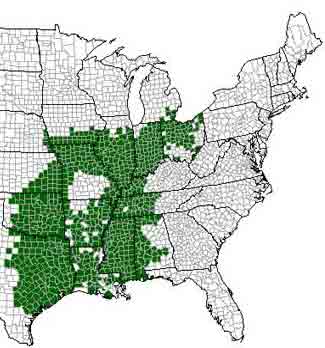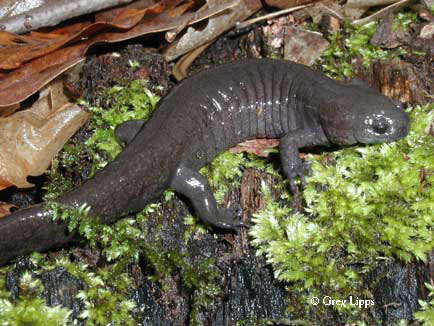
Small-mouth Salamander
(Ambystoma texanum)
 |
 |
|
|
Distribution of the Small-mouth Salamander (from the AR MI Atlas)
|
An adult Small-mouth Salamander.
|
|
Description: Best identified by its short snout, which is narrow and strongly convex in profile. The lower jaw projects slightly forward beyond the upper jaw. Other characteristics include a small head, legs with short, stout digits and a ground color from black to brown, some with lichen-like blotches on their sides. The belly is of the same color with little or no speckling. |
||
Distribution in Ohio: Mainly found in northern half of the state. |
||
|
|
||
Status in Ohio: Widespread and common in some areas. |
||
|
|
||
Habitat: Forested floodplains, swamp forests, and deciduous forests. The Small-mouthed Salamander breeds in vernal pools within these areas and spends the rest of the year hidden in underground burrows or under logs, leaf litter, or other debris. |
||
|
|
||
Life history: Courtship, breeding, and egg-laying all occur underwater. Migrations to breeding pools usually occurs with the first warm rains in the late winter or early spring. Usually small clusters each containing only a few eggs are deposited by the females on twigs, leaves or the pond bottom, but some may lay larger, flimsy, sausage-shaped clusters containing as many as 15 eggs. The aquatic larvae hatch a few weeks later and complete metamorphosis in June and July. |
||
|
|
||
Conservation: The Small-mouthed Salamander relies on vernal pools for breeding and adjacent forested habitat for their adult life. Threats to this species include wetland filling and draining, introduction of fish to breeding ponds, pollutants, such as insecticides and herbicides, and loss of adult habitat. |
||
Last modified:
|
Ohio Amphibians · Ohio Salamander Web · Ohio Salamander Species · Amphibian Habitats · Salamander Monitoring |
|